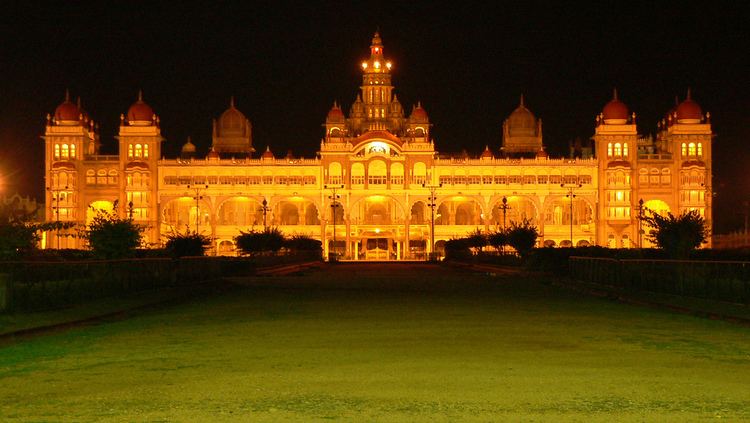 | ||
Mysore dasara 1 10 birds eyeview
Mysore Dasara is the Nadahabba (state-festival) of the state of Karnataka in India. It is also called Navaratri (Nava-ratri = nine-nights) and is a 10-day festival with the last day being Vijayadashami, the most auspicious day of Dasara. Dasara usually falls in the month of September or October. According to a legend, Vijayadashami denotes the victory of truth over evil and was the day when the Hindu Goddess Chamundeshwari (Durga) killed the demon Mahishasura. Mahishasura is the demon whose slaying by the Goddess gave the name Mysore. The city of Mysore has a long tradition of celebrating the Dasara festival with utter grandeur and pomp to mark this day and the festivities there are an elaborate affair, attracting a large audience including foreigners. The Dasara festival completed 400th anniversary in year 2010.
Contents
- Mysore dasara 1 10 birds eyeview
- Mysore dasara 2016 mysuru dasara dussehra
- History
- Festivities
- Lighting at Mysore Palace
- Procession
- Exhibition
- Other programmes
- References
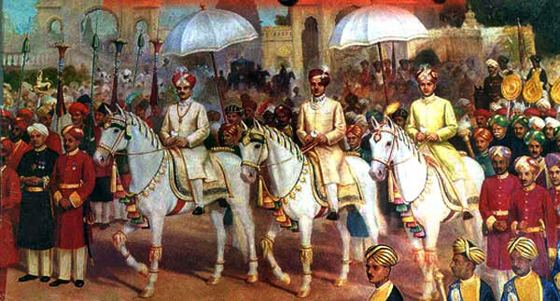
Mysore dasara 2016 mysuru dasara dussehra
History
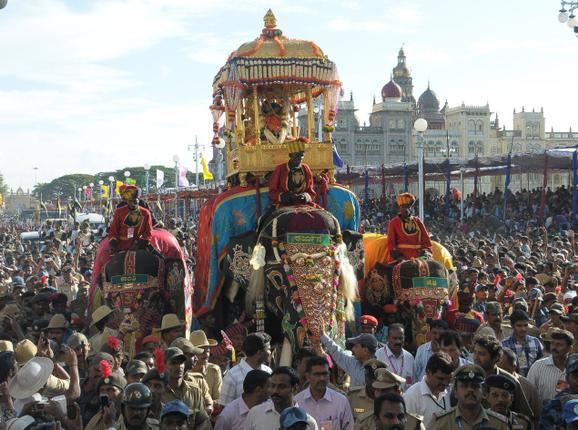
The Dasara festivities began with the Vijayanagar kings as early as the 15th Century. The festival played a historical role in the 14th-century Vijayanagara Empire, where it was called Mahanavami. The Italian traveller Niccolò de' Conti described the festival's intensity and importance as a grandeur religious and martial event with royal support. The event revered Durga as the warrior goddess (some texts refer to her as Chamundeshwari). The celebrations hosted athletic competitions, singing and dancing, fireworks, a pageantry military parade and charitable giving to the public.
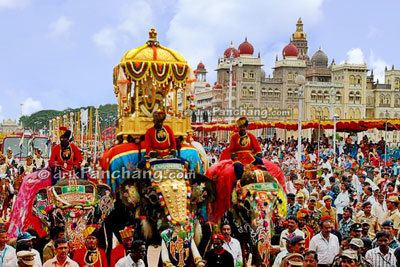
After the fall of the Vijayanagar to Deccan Sultanates, these Hindu celebrations came to an end under the Muslim rulers. The Wodeyars of Mysore observed the Dasara Festival, initially by Raja Wodeyar I (1578-1617 CE) in the year 1610 at Srirangapatna.
Festivities
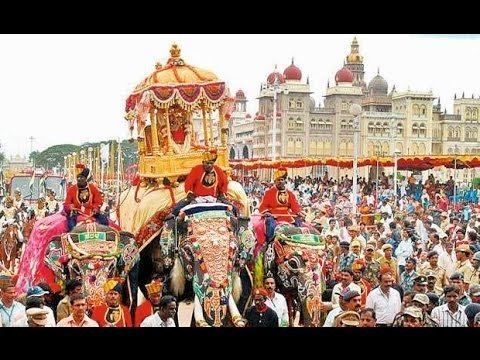
The festivities included a special durbar (royal assembly). It was during the reign of Krishnaraja Wodeyar III in the year 1805, when the king started the tradition of having a special durbar in the Mysore Palace during Dasara; which was attended by members of the royal family, special invitees, officials and the masses. After the death of Srikanta Wadiyar in December 2013, this tradition has been continued by placing the “Pattada Katti” (royal sword) on the golden throne. The ninth day of Dasara called as Mahanavami is also an auspicious day on which the royal sword is worshipped and is taken on a procession involving elephants, camels and horses.
Lighting at Mysore Palace
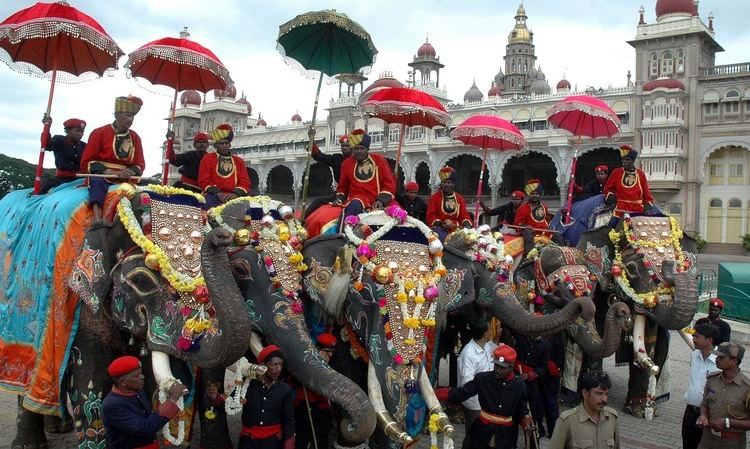
The main attraction of the ten-day Mysore Dasara festival is the Mysore Palace which is illuminated daily with nearly 100,000 light bulbs from 7 pm to 10 pm on all days of the festival. Nearly ₹10 million is spent towards maintenance of its illumination alone every year. Various cultural and religious programs highlighting the dance, music and culture of the State of Karnataka are performed in front of the illuminated Palace.
Procession
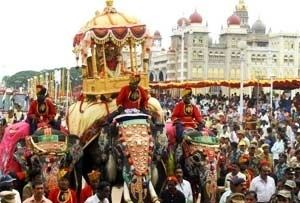
On Vijayadashami, the traditional Dasara procession (locally known as Jumboo Savari) is held on the streets of Mysore city. The main attraction of this procession is the idol of the Goddess Chamundeshwari which is placed on a golden mantapa (which is around 750 kilograms of gold) on the top of a decorated elephant. This idol is worshipped by the royal couple and other invitees before it is taken around in the procession. Colourful tableaux, dance groups, music bands, decorated elephants, horses and camels form a part of the procession which starts from the Mysore Palace and culminates at a place called Bannimantap where the banni tree (Prosopis spicigera) is worshipped. According to a legend of the Mahabharata, banni tree was used by the Pandavas to hide their weapons during their one-year period of Agnatavasa (living life incognito). Before undertaking any warfare, the kings traditionally worshipped this tree to help them emerge victorious in the war. The Dasara festivities would culminate on the night of Vijayadashami with an event held in the grounds at Bannimantap called as Panjina Kavayatthu (torch-light parade).
In Mysore, India, the Vijayadashami Elephant procession during Mysore Dasara is called Jumbo Savari (from the British during their control of Mysore State). The original name to this procession is Jumbi Savari ("going to the Shami (Banni) tree"). Now Goddess Chamundeshwari is taken in procession on an Elephant. But the "Jumbo" name is still intact.
After the Jamboo Savari, a torchlight parade takes place in the evening at the Bannimantap Parade Grounds.
Exhibition
Another major attraction during Dasara is the Dasara exhibition which is held in the exhibition grounds opposite to the Mysore Palace. The exhibition was started by the Maharaja of Mysore Chamaraja Wodeyar X in 1880 with the sole aim of introducing timely developments to the people of Mysore. The task of holding the exhibition is now entrusted with the Karnataka Exhibition Authority (KEA). This exhibition starts during Dasara and goes on till December. Various stalls which sell items like clothes, plastic items, kitchenware, cosmetics and eatables are set up and they attract a significant number of people. A play area containing attractions like a Ferris wheel is also present to provide entertainment to the people. Various Governmental agencies setup stalls to signify the achievements and projects that they have undertaken.
In the year 1981 Karnataka Exhibition Authority was constituted to organize the exhibition besides looking into the proposed construction of Karnataka Kalamandira, Vishwa Kannada Sammelana guest house and shopping complex. The construction of the aforementioned buildings was completed in 1985 and they were handed over to the Kannada and Culture Department and PWD Department respectively following the government order on 1 April 1989. The task of conducting the Dasara exhibition was entrusted to Karnataka Exhibition Authority in 1987. From 1987 to 1993 the exhibition was conducted under the banner of the Information, Tourism and Youth Affairs Departments, and from 1994 to 2003 under the banner of the Kannada and Culture, Information and Tourism Departments.
Other programmes
On all the 10 days of Dasara, various music and dance concerts are held in auditoriums around Mysore city. Musicians and dance groups from all over India are invited to perform on this occasion. Another attraction during Dasara is the Kusti Spardhe (wrestling-bout) which attracts wrestlers from all around India.
